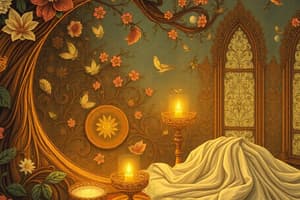Podcast
Questions and Answers
Which literary device primarily creates the rhythm in the stanza of the poem?
Which literary device primarily creates the rhythm in the stanza of the poem?
- Mood
- Figure of speech
- Tone
- Meter (correct)
What is the meaning of 'Iambic meter' as described?
What is the meaning of 'Iambic meter' as described?
- A rhythmic pattern with two stressed syllables
- A uniform pattern of unstressed syllables
- A rhythmic pattern with alternating stressed and unstressed syllables (correct)
- A rhyme scheme involving four lines
Which of the following best defines 'tone' in literature?
Which of the following best defines 'tone' in literature?
- The rhythm of the poem
- The general atmosphere of a piece
- The author’s attitude towards the subject (correct)
- The emotional response intended for the reader
What is the primary function of a simile in literature?
What is the primary function of a simile in literature?
How does a metaphor differ from a simile?
How does a metaphor differ from a simile?
What is personification used for in literature?
What is personification used for in literature?
Which of the following is NOT a characteristic of an ode?
Which of the following is NOT a characteristic of an ode?
What is the structure of a sonnet?
What is the structure of a sonnet?
Which of the following examples best illustrates personification?
Which of the following examples best illustrates personification?
What does the term 'theme' refer to in literature?
What does the term 'theme' refer to in literature?
Which statement about the structure of a sonnet is accurate?
Which statement about the structure of a sonnet is accurate?
What type of imagery is used in the description of 'the tallest structures of concrete sandstone'?
What type of imagery is used in the description of 'the tallest structures of concrete sandstone'?
What does the phrase 'wrote with his plow a tongue-tied love' imply about the character in 'The Lover's Death'?
What does the phrase 'wrote with his plow a tongue-tied love' imply about the character in 'The Lover's Death'?
Flashcards are hidden until you start studying
Study Notes
The Day I Lost You
- Poem expressing intense grief and emotional turmoil following the loss of the speaker's mother.
- Uses vivid imagery and strong emotional language: "My body is quivering," "The pain is excruciating," "My heart is breaking."
- Compares the heart's throbbing to "the sound of the drums / Beaten by a mad musician."
Lyric Poetry
- Expresses the speaker's personal emotions and feelings.
- Combines elements of song lyrics and poetry.
- Often accompanied by musical instruments (harp, lyre).
Features of Lyric Poetry
- Song-like quality.
- Exploration of emotions and personal feelings.
- Use of literary devices to highlight the poet's purpose.
Literary Devices in Poetry
- Meter: Rhythmic pattern of a poem's stanzas, focusing on stressed/unstressed syllables. Iambic meter is an example: unstressed syllable followed by a stressed syllable (duh-DUH).
- Mood: The emotional response the author wants the reader to feel (e.g., hopeful, angry, humorous, cheerful, romantic).
- Tone: The author's attitude toward the subject (e.g., formal, optimistic, encouraging, curious).
- Figures of Speech: Words or phrases used unconventionally to create a specific effect. Includes simile (comparison using "like" or "as"), metaphor (direct comparison), and personification (giving human qualities to non-human things).
- Theme: The central idea explored in the text (examples from text: "Beware of strangers," "Good triumphs over evil").
Forms of Lyric Poetry
- Sonnets: 14-line poem, typically in iambic pentameter (e.g., Shakespeare's sonnets).
- Odes: Formal poems addressing, praising, or giving tribute to a person, thing, place, or idea.
- Elegies: Sad poems often expressing sorrow over someone's death.
Purposes of Writing
- To persuade the reader to agree with a viewpoint or take action.
- To inform the reader about a topic.
- To entertain the reader.
Studying That Suits You
Use AI to generate personalized quizzes and flashcards to suit your learning preferences.




